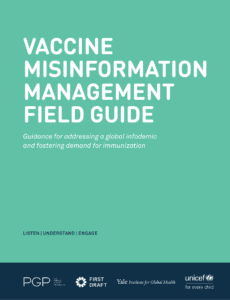Misinformation Alerts
Knowing what misinformation is being shared can help you generate effective messaging.
These insights are based on a combination of automated media monitoring and manual review by public health data analysts. Media data are publicly available data from many sources, such as social media, broadcast television, newspapers and magazines, news websites, online video, blogs, and more. Analysts from the Public Good Projects triangulate this data along with other data from fact checking organizations and investigative sources to provide an accurate, but not exhaustive, list of currently circulating misinformation.
Misinformation Alerts
Knowing what misinformation is being shared can help you generate effective messaging.
These insights are based on a combination of automated media monitoring and manual review by public health data analysts. Media data are publicly available data from many sources, such as social media, broadcast television, newspapers and magazines, news websites, online video, blogs, and more. Analysts from the Public Good Projects triangulate this data along with other data from fact checking organizations and investigative sources to provide an accurate, but not exhaustive, list of currently circulating misinformation.Alerts are categorized as high, medium, and low risk.
- High risk alerts: Narratives with widespread circulation across communities, high engagement, exponential velocity, and a high potential to impact health decisions. Are often more memorable than accurate information.
- Medium risk alerts: Narratives that are circulating in priority populations and pose some threat to health. Potential for further spread due to the tactics used or because of predicted velocity. Often highlights the questions and concerns of people.
- Low risk alerts: Narratives that are limited in reach, don’t impact your community, or lack the qualities necessary for future spread. May indicate information gaps, confusion, or concerns.
A widely shared social media post speculates that an unvaccinated tennis player was banned from the U.S. Open because the tournament was sponsored by Moderna. The player made international headlines late last year for his refusal to be vaccinated against COVID-19 in order to participate in the Australian Open.
Recommendation: Responding to each piece of misinformation may detract from priority talking points. The U.S. requires that all noncitizens entering the country, including professional athletes, provide proof of COVID-19 vaccination. The player confirmed that he won’t be playing in the tournament because he cannot travel to the U.S. while unvaccinated. Fact-checking sources:
In an interview earlier this month, Dr. Anthony Fauci, director of the U.S. National Institute of Allergy and Infectious Diseases, explained how OPV is connected to the recent New York polio case in an unvaccinated adult. The out-of-context video clip has been shared on social media alongside misinformation about vaccine-derived poliovirus and the safety of polio vaccines.
Recommendation: The high-profile nature of this misinformation elevates its risk. Misconceptions about vaccine-derived polio are persistent and take time to combat. Consider countering misinformation about vaccine-derived polio by explaining that vaccines protect against all forms of polio. Emphasizing that this type of vaccine-derived polio is extremely rare and only dangerous to unvaccinated people is recommended. Messaging may also explain that the best way to prevent any type of polio outbreak—whether wild polio or vaccine-derived—is to vaccinate all children. Fact-Checking Source(s): 
A widely circulated article falsely claims that 44 percent of pregnant women in the Pfizer vaccine trial experienced a miscarriage following vaccination. The article has since been corrected to note that the analysis has been retracted due to basic miscalculations. The post is circulating in Black and Spanish-speaking communities.
Recommendation: Emphasizing that the flawed analysis has been retracted is recommended. Messaging may emphasize that there is no evidence to support the claim that COVID-19 vaccines increase miscarriage risk. Data from multiple large studies show that the vaccines do not increase the risk of miscarriage, stillbirth, or other adverse pregnancy outcomes. Explaining that COVID-19 vaccines are safe for both pregnant people and their babies is recommended. Fact Checking Source(s): 
In a recently resurfaced video clip, a military doctor testifies that she was forced to cover up COVID-19 vaccine injuries. The doctor also claims that military data reveals widespread vaccine injuries, a false claim that the Department of Defense refuted months ago. The same doctor wrote an affidavit in a lawsuit challenging the Pentagon’s vaccine mandate, in which she falsely claimed that the Pfizer vaccine contains anti-freeze and used unverified VAERS data to claim that COVID-19 vaccines have killed thousands of people.
Recommendation: Responding to each piece of misinformation may detract from priority talking points. The claims made in the doctor’s testimony are baseless and have been repeatedly disproven. Evidence that vaccines are deadly is limited to unverified data in vaccine monitoring systems and anecdotes shared online. Fact-checking sources:
In a video clip, a tech entrepreneur known for his misinformed criticism of COVID-19 vaccines baselessly claims that COVID-19 vaccines have killed hundreds of thousands of people and injured millions of others. The clip has been widely circulated on English and Spanish social media, with one popular post receiving hundreds of thousands of views.
Recommendation: Messaging may emphasize that there is no evidence to support the extraordinary claim that COVID-19 vaccines are causing widespread injury and death. Evidence that vaccines are deadly is limited to unverified data in vaccine monitoring systems and anecdotes shared online. Continuing to reiterate that the COVID-19 vaccines are safe is recommended. Fact Checking Source(s): 
An Icelandic study is being used to claim that the COVID-19 reinfection rate increases with each vaccine dose. The study investigated broad reinfection trends and found that a slightly higher proportion of people who tested positive for COVID-19 reinfection had received two or more vaccine doses. A physician known for promoting vaccine misinformation shared the article on social media, where it received high engagement.
Recommendation: Emphasizing the flaws in the posts’ interpretation of the study’s purpose and findings is recommended, as is explaining that the researchers explicitly state that the findings did not enable them to identify factors that influence reinfection rates. The analysis also did not include data about vaccine type, time since last vaccine dose, COVID-19 exposure risk, underlying conditions, or frequency of COVID-19 testing, which would be necessary to determine if vaccination status influences reinfection risk. Fact Checking Source(s): 
The CDC recently updated its COVID-19 guidance to make the same recommendations for people who have been exposed to COVID-19 regardless of their vaccination status. Some social media users are claiming that the updated guidelines mean that there was never a difference in COVID-19 risk for vaccinated and unvaccinated people and that previous guidelines were misguided.
Recommendation: Before the dominance of Omicron subvariants, vaccinated people were far better protected than unvaccinated people against contracting and spreading COVID-19. The virus has undergone mutations that make Omicron subvariants significantly more transmissible and better able to evade immunity from vaccines and infection, making the updated guidelines with respect to vaccination status defensible, despite ongoing debate among experts regarding the timing and scope of rolling back public health measures. Continuing to emphasize that vaccinated people are at lower risk than unvaccinated people of severe illness and death from Omicron is recommended. Fact Checking Source(s): 
An article that is trending on social media falsely claims that a "bombshell" study found that vaccinated people are five times more contagious and are contagious for a longer time after COVID-19 infection than unvaccinated people. The article has been widely shared online.
Recommendation: The researchers say that the article and those sharing it are misrepresenting the study, which found no difference in infectiousness based on vaccination status and that vaccinated people were contagious for one day less than unvaccinated people. Explaining that the claim that vaccinated people are more contagious is based on a misunderstanding of the tests used in the study to measure the presence of SARS-CoV-2 and the infectiousness of the virus present is recommended. Fact Checking Source(s): 
A website that is known for publishing hoaxes and fabricated news stories is claiming that data from a German health insurer suggests that one in 25 of the insurer’s clients were treated for COVID-19 vaccine side effects last year. The article is based on totaling the use of four diagnosis health insurer codes.
Recommendation: Emphasizing the flaws in this article is recommended. Only one of the codes included in the data request is specific to COVID-19 side effects. Two of the codes relate to side effects from any vaccine, and the fourth code relates to side effects from any “biologically active” substance, which may include vaccines. None of the codes take the severity of the side effect into account and may include mild side effects like headaches or pain at the injection site. Fact Checking Source(s): 
A site known for promoting misinformation and conspiracy theories published two articles falsely claiming that COVID-19 vaccines are deadly. The first article claimed that COVID-19 boosters have killed one in every 800 people over the age of 60, based on a tenuous correlation between vaccination and excess mortality rates. The second article claims that there have been twice as many deaths from vaccines as from COVID-19, based on an unverified, self-reported survey conducted by a tech entrepreneur best known for his misinformed criticism of COVID-19 vaccines.
Recommendation: No data about cause of death or vaccination status was included in the first article, making it impossible to draw conclusions about the vaccines’ potential role in excess deaths. While COVID-19 death data is based on official reports from state health departments and federal health authorities, the data in the second article is based on unverified responses to a survey. Around 15,000 deaths after COVID-19 vaccination have been reported to VAERS—which contains user-submitted, unverified reports—and analyses of these deaths have not revealed that a significant number were caused by the vaccines. Emphasizing that these reporting systems contain unverified reports while directing to actual evidence is recommended, as is continuing to explain what mild side effects people can expect after vaccination. Fact Checking Source(s): 
Alerts are categorized as high, medium, and low risk.
- High risk alerts: Narratives with widespread circulation across communities, high engagement, exponential velocity, and a high potential to impact health decisions. Are often more memorable than accurate information.
- Medium risk alerts: Narratives that are circulating in priority populations and pose some threat to health. Potential for further spread due to the tactics used or because of predicted velocity. Often highlights the questions and concerns of people.
- Low risk alerts: Narratives that are limited in reach, don’t impact your community, or lack the qualities necessary for future spread. May indicate information gaps, confusion, or concerns.
Vaccine Misinformation Guide
Get practical tips for addressing misinformation in this new guide. Click image to download, or see highlights.

